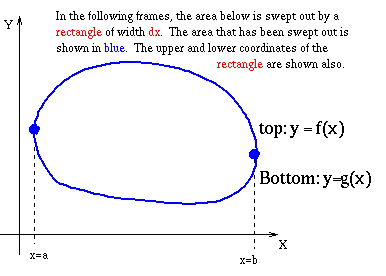The crucial step for integrating functions over a general region is using
the graph of the region to get the boundaries correct. You'll be trying to
evaluate the integral ![]() with four boundaries, as either
with four boundaries, as either


while the integral on the right corresponds sweeping horizontal rectangles vertically.
To set up the integral, first decide which order you want to integrate. We'll speak more on how to choose this in the next section. Let's say we choose to integrate in the x direction (horizontally) first. In this case, the limits on the x integral could be functions of y in order to describe the left and right boundaries. The limits on the outer integral in y must be constant, though. Otherwise, you would get a function as the result of the integral, not a number. In general,
Thus, we can have double integrals of these forms:
